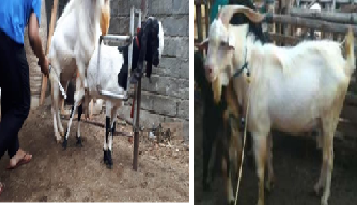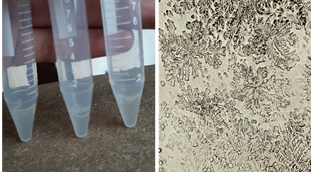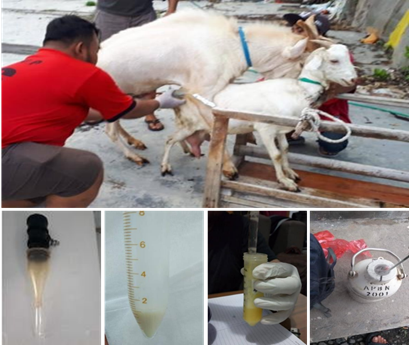Incidence and associated risk factors of uterine prolapse in dairy cows in Manoharganj Upazila, Cumilla District, Bangladesh

Downloads
Uterine prolapse is a medical emergency in cows that can be life-threatening if not promptly treated. This study aimed to determine the incidence, associated risk factors, survival rate, conception rate, and management practices related to uterine prolapse in dairy cows in Manoharganj Upazila, Cumilla District, Bangladesh. Data collected from cow owners were analyzed using the Chi-square test. A total of 102 cases of uterine prolapse were manually corrected. The incidence was found to be higher in crossbred (61.76%) compared to local (38.24%) cows. Similarly, cows that were artificially inseminated showed a significantly higher incidence (93.14%) than those bred naturally (6.86%). Pluriparous cows had a greater incidence (77.45%) than primiparous cows (22.55%). Additionally, cows with a previous history of vaginal prolapse (48.04%) or dystocia (59.80%) were more likely to experience uterine prolapse than those without such histories. Following treatment, 91.18% of the affected cows survived, while 8.82% died. Among the survivors, 15.05% were culled, and the remaining cows were artificially inseminated of which 82.27% successfully conceived. The study also observed that 3.92% of cows were diagnosed with hypocalcemia shortly after prolapse correction. These findings highlight the importance of immediate veterinary intervention and the need for proper nutritional management during pregnancy to help prevent uterine prolapse.
Ali GMT, Amin ASMF. 2016. Causes and treatment of dystocia in cows in Sulaimani Province. Assiut Vet Med J. 62: 152-7.
Bahrami-Yekdangi M, Ghorbani GR, Sadeghi-Sefidmazgi A, Mahnani A, Drackley JK, Ghaffari MH. 2022. Identification of cow level risk factors and associations of selected blood macro-minerals at parturition with dystocia and stillbirth in Holstein dairy cows. Sci Rep. 12: 5929.
Bhattacharyya HK, Fazili MR, Buchoo BA, Akand AH. 2012. Genital prolapse in crossbred cows: prevalence, clinical picture and management by a modified Bühner’s technique using infusion (drip) set tubing as suture material. Vet Arh. 82: 11-24.
Bhattacharyya HK, Peer FU, Buchoo BA, Ansari MM. 2007. Management of uterine prolapse in cattle. Indian Vet J. 84: 744-5.
Bhoi D, Parekar S. 2009. Post-partum uterine prolapse in a non-descript buffalo. Vet World 2: 149.
Borsberry S, Dobson H. 1989. Periparturient diseases and their effect on reproductive performance in five dairy herds. Vet Rec. 124: 217-9.
Carluccio A, De Amicis I, Probo M, Giangaspero B, Veronesi MC. 2020. Prevalence, survival and subsequent fertility of dairy and beef cows with uterine prolapse. Acta Vet Hung. 68: 91-4.
Deka RP, Magnusson U, Grace D, Randolph TF, Shome R, Lindahl JF. 2021. Estimates of the economic cost caused by five major reproductive problems in dairy animals in Assam and Bihar, India. Animals (Basel) 11: 3116.
Dobson-Hill B. 2009. Uterine involution in the dairy cow: Comparative study between organic and conventional dairy cows. M.Sc. Thesis. Massey University. Palmerston North, New Zealand.
Gowda KH, Madhu BP, Madhusudhan HS. 2014. Management of postpartum uterine eversion in a buffalo. Intas Polivet 15: 428-30.
Hasan T, Azizunnesa PM, Paul P, Akter SFM, Hossain D. 2017. Correction and management of vaginal prolapse in a cow by Buhner’s technique. Res J Vet Pract. 5: 1-4.
Ishii M, Aoki T, Yamakawa K, Uyama T, El-khodery S, Matsui M, Miyake Y. 2010. Uterine prolapse in cows: Effect of raising the rear end on the clinical outcomes and reproductive performance. Vet Med. 55: 113-8.
Ismail ZB. 2016. Epidural analgesia in cattle, buffalo, and camels. Vet World 9: 1450.
Jana D, Ghosh M. 2009. Post partum uterine prolapse in an indigenous pluriparous cow and its therapeutic management. Intas Polivet 10: 20-1.
Joseph C, Kulasekar K, Balasubramanian S, Kathiresan D, Veerapandian C, Pattabiraman SR. 2001. An unusual complication of post-partum uterine prolapse in a she-buffalo-a case report. Indian Vet J. 78: 57-8.
Jubb TF, Malmo J, Brightling P. 1990. Survival and fertility after uterine prolapse in dairy cows. Aust Vet J. 67: 22-4.
Juneja R, Sain A, Bansal KN, Harizan IM, Katara A. 2022. Mini review on uterine prolapse in bovine: Treatment and management. The Pharma Innov J 11: 1229-1231.
Lara E, Velasquez A, Cabezas J, Rivera N, Pacha P, Rodrıguez- Alvarez L, Saravia F, Castro FO. 2017. Endometritis and in vitro PGE2 challenge modify properties of cattle endometrial mesenchymal stem cells and their transcriptomic profile. Stem Cell Int. 2017: 4297639.
Mardotillah K, Utama S, Safitri E, Hermadi HA, Madyawati SP, Legowo D, Hasib A. 2024. Uterine prolapse and related factors in beef cow at the Besuki Animal Health Center, Situbondo regency, East Java, Indonesia. Ovozoa J Anim Reprod. 13: 146-52.
Martin AD, Groseth PK, Munthe-Kaas M, Nødtvedt A. 2023. Treatment and survival of Norwegian cow after uterine prolapse. Acta Vet Scand. 65: 38.
Matamala F, Strappini A, Sepúlveda-Varas P. 2021. Dairy cow behaviour around calving: Its relationship with management practices and environmental conditions. Austral J Vet Sci. 53: 9-22.
Miesner MD, Anderson DE. 2008. Management of uterine and vaginal prolapse in the bovine. Vet Clin North Am Food Anim Pract. 24: 409-19.
Murphy A, Dobson H. 2002. Predisposition, subsequent fertility, and mortality of cows with uterine prolapse. Vet Rec. 151: 733-5.
Noakes DE. 2019. Prolapse of the cervix and vagina. In: Noakes DE, Parkinson TJ, England GCW (Eds). Veterinary Reproduction and Obstetrics. 10th Ed. Elsevier. 195-201.
Noakes DE. 2001. Postparturient prolapse of the uterus. In: Noakes DE, Parkinson TJ, England GCW (Eds). Arthur’s Veterinary Reproduction and Obstetrics. 8th Ed. Harcourt (India) Pvt. Ltd., New Delhi, India. 333-8.
Odegaard SA. 1977. Uterine prolapse in dairy cows. A clinical study with special reference to incidence, recovery and subsequent fertility. Acta Vet Scand Suppl. 63: 1-124. 271460.
Peter AT. 2015. Vaginal, cervical and uterine prolapse. In: Hopper RM (Ed). Bovine reproduction. 1st Ed. Wiley and Sons Inc. 383-95.
Potter TJ. 2008. Prolapse of the uterus in the cow. UK Vet. 13: 25-8.
Purohit GN, Arora AS, Gocher T, Gaur M, Saraswat CS, Mishra P. 2018. Uterine prolapse in buffaloes: A review. Asian Pac J Reprod. 7: 241-7.
Richardson GF, Klemmer A, Knudsen D. 1981. Observations on uterine prolapse in beef cattle. Can Vet J. 22: 189-91.
Risco CA, Reynolds JP, Hird D. 1984. Uterine prolapse and hypocalcemia in dairy cows. J Am Vet Med Assoc. 185: 1517-9.
Roberts SJ. 1986. Injuries and diseases of the puerperal period. Veterinary Obestetric and Genital Diseases. p: 353-396.
Srivastava N, Pande M. 2018. Genital prolapse in bovines a farmer’s perspective. Indian Farming 66: 47-50.
Tyagi RPS, Singh J. 2019. Ruminant surgery: A textbook of the surgical diseases of cattle, buffaloes, camels, sheep and goats. 2nd Ed. CBS Publishers and Distributors Pvt. Ltd., New Delhi, India.
Ward H, Powell J. 2018. Reproductive prolapses of cow. University of Arkansas, United States Department of Agriculture and County Governments Cooperating.
Wasef A, Islam MR. 2024. Incidence and management of dystocia of dairy cows in Manoharganj upazila of Cumilla district, Bangladesh. Ovozoa: J Anim Reprod. 13: 178-85.
Copyright (c) 2025 Al Wasef, Uday Kumar Mohanta, Vijay Kumar Sah, Md. Rashedul Islam, Nita Khadka, Nabina Budhathoki, Md. Shakil Islam

This work is licensed under a Creative Commons Attribution-ShareAlike 4.0 International License.
Ovozoa by Unair is licensed under a Creative Commons Attribution-ShareAlike 4.0 International License.
1. The journal allows the author to hold the copyright of the article without restrictions.
2. The journal allows the author(s) to retain publishing rights without restrictions
3. The legal formal aspect of journal publication accessibility refers to Creative Commons Attribution Share-Alike (CC BY-SA).
4. The Creative Commons Attribution Share-Alike (CC BY-SA) license allows re-distribution and re-use of a licensed work on the conditions that the creator is appropriately credited and that any derivative work is made available under "the same, similar or a compatible license”. Other than the conditions mentioned above, the editorial board is not responsible for copyright violation.




































